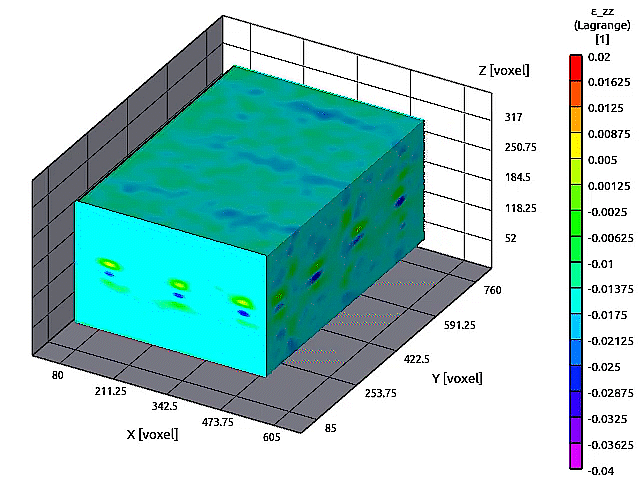

Non-Contact Internal Strain Measurement System
VIC-Volume is an exciting addition to the VIC product line. VIC-Volume utilizes images from X-Rays or CT-Scanners (or other volumetric imaging systems) to measure internal deformation of a specimen under an applied load. VIC-Volume analyzes the acquired images to create three-dimensional volumetric displacement and strain data of the specimen’s internal behavior. The resulting data is a full-field contour plot of the deformation data that can be viewed, animated, and extracted for FEA validation.
Technology Background
Digital volume correlation (DVC) is a quantitative image analysis technique for measuring internal deformation of a volume from image slices acquired via an X-Ray or CT scanner. The theory is similar to 2D and 3D DIC analysis, except the z dimension (through the material) is added allowing for full characterization of the material. To achieve this measurement the DVC algorithm tracks displacement information from small volumes called voxels, similar to pixel subset tracking in 2D and 3D DIC analysis. These voxels are the building blocks of the sub-volume. Image matching is then performed to locate sub-volumes in a series of images with optimal accuracy. The voxel matching is performed through minimization or maximization of a metric function that quantifies the level of similarity in sub-volumes between the reference and deformed volumetric images. The result is a 3D volumetric data set containing the selected strain tensor variables, which now includes the z strain components (Exz, Eyz, & Ezz).
How do I create a speckle pattern for DVC?
Similar to DIC, DVC requires a random high contrast pattern to reliably tracked the deformation. This can be a challenge for DVC, because now the speckle pattern is created from the change in density through the material. To achieve this, particles with lower or higher densities can be added to the material, or in some cases, natural occurrences within the material will produce an image with enough contrast for the DVC algorithm to generate high-quality data. In the application example below, sand particles were added to the uncured rubber to produce a high-quality speckle pattern. In cases where introducing artifacts into the material may not be possible, a simple static CT or X-Ray scan of your material will allow our engineers to evaluate if VIC-Volume will work for your material(s). This service is completely free of charge to potential buyers.
Setup
The diagram to the right displays a typical setup of how the images are acquired during a test. The scanner acquires images at specific depth coordinates, and then VIC-Volume analyzes the image slices to construct a 3D volume made up of voxels. The individual voxels are the building blocks for the sub-volume, which contain the volumetric image correlation data.
Software Features
Convenient AOI selection method through “Tweening’’
Semi-automatic initial guess computation
Optimized for accuracy using non-linear optimization to reduce bias and interpolation artifacts
Highly advanced memory management permits analysis of huge volumetric data sets
Volumetric 3D displacements & strains
Our sales and support engineers will work with you to find the best volumetric imaging hardware for your needs and make sure it is implemented properly with the VIC-Volume software



